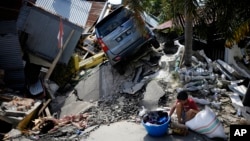Desperation and frustration is rising on the central Indonesian island of Sulawesi, where more than 1,200 people were killed in last week's devastating earthquake and tsunami.
Reports from the scene say residents in Palu, the city hardest hit by the disaster, are looting abandoned stores in a search for food and clean water, growing angrier with each passing hour over the government's slow response in delivering emergency aid. Meanwhile, rescue crews continue to dig among the rubble scattered across Palu in a frantic search for any survivors, but their efforts have been hampered by a lack of heavy machinery. At least 50 people alone are believed trapped beneath the ruins of the city's Hotel Roa Roa.
Indonesia's national disaster agency announced Tuesday that the death toll now stands at 1,234 from last Friday's 7.5 magnitude earthquake, which triggered a huge tsunami with waves as high as six meters. Scores of houses and buildings in Palu were turned into huge mounds of debris, leaving as many as 50,000 residents displaced.
The tsunami also washed out Sulawesi's roads and bridges, and wrecked the island's airport, hindering efforts to deliver relief supplies. About 3,000 residents flocked to the airport Monday in hopes of catching a military cargo plane or a rare commercial airline to take them off the island.
Among the charities responding to the disaster is Save the Children. Spokesman Faraj Jasmin told VOA from the Indonesian capital of Jakarta that one of the biggest obstacles to recovery continues to be the lack of access to affected areas.
"The flooding water has subsided but the biggest problem with access is that the main roads are basically very much damaged," Jasmin said. "I’m talking about interconnecting bridges that are broken in two. The ground beneath them, the foundation where they were lied upon shifted. Some of them are completely broken down and not connected anymore. Whatever roads we have left connecting these areas are heavily bottlenecked."
Jasmine said medical personnel treating victims are "overwhelmed" and added "They are running with shortages of medical supplies and health staff. Management of injuries, medical and health services, food and non-food items, these are what people are becoming a little bit desperate about."
Emergency officials fear the death toll will rise as rescue crews reach three districts near Palu that were cut off by the disaster. The three areas have a combined population of over one million people.The region was struck by at least one moderate aftershock on Tuesday. There have been no reports of any casualties or damage.
President Jokowi Widodo has authorized the acceptance of international help for Sulawesi.
"The United States will provide initial assistance and continue to work with the government of Indonesia and our Mission in Indonesia to determine how best to respond," a U.S. State Department official said Tuesday.
Authorities say hundreds of people were on the beach in Palu for a festival when the earthquake and tsunami struck, sweeping many away to their deaths when the giant waves arrived.
Indonesia had been working with the U.S. National Science Foundation on a prototype tsunami early warning system that picks up changes in the water column on the ocean floor.
But the project was put on hold last week, apparently because the recent devaluation of the Indonesian currency created concerns in Indonesia about how to pay for its share of the project.
Indonesia and its 18,000 islands are located along the Pacific Ocean's "Ring of Fire" and are frequently struck by earthquake, volcano and tsunami activity.
A 9.1-magnitude quake in 2004 off Sumatra and subsequent tsunami killed about 230,000 people in 14 Pacific countries, with about half of those deaths occurring in Indonesia.
VOA's Victor Beattie and VOA State Department Correspondent Nike Ching contributed to this report.



